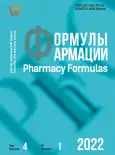Approaches to radiation situation assessment and prediction in the Baltic Sea
- Authors: Savkina E.A.1, Sklyarova L.V.2, Podboronova A.G.3,4, Zharikov M.5,6, Perelygin I.V.7
-
Affiliations:
- Saint Petersburg State Chemical and Pharmaceutical University of the Ministry of Health of the Russian Federation
- Saint Petersburg State University of Chemistry and Pharmacy of the Ministry of Health of the Russian Federation
- Saint Petersburg State Chemical and Pharmaceutical University
- V.G. Khlopin Radium Institute
- Saint Petersburg State Chemical Pharmaceutical University
- North-West Institute of medical and biological problems and environmental protection
- Lesgaft National State University of Physical Education, Sport and Health, Saint Petersburg, Russia
- Issue: Vol 4, No 1 (2022)
- Pages: 52-60
- Section: Biological sciences
- URL: https://journals.rcsi.science/PharmForm/article/view/108693
- DOI: https://doi.org/10.17816/phf108693
- ID: 108693
Cite item
Full Text
Abstract
The review is devoted to the analysis of scientific publications, as well as regulatory legal acts and documents in the field of radioecology and radiation situation assessment in the Baltic Sea. To date, certain areas of the Baltic Sea are classified as environmentally unfavorable in terms of a number of harmful (polluting) substances that have a negative impact on the environment, including radiation conditions.
The article deals with two main aspects of radioecology problems: international and regional (Russian) within the Baltic Sea. Potentially hazardous objects and the main radioecological problems that are relevant at this time and require scientific and practical solutions have been analyzed.
The objects of negative impact in the course of the study were taken into account generally accepted four main components with different concentrations of pollutants: water, organisms and suspended organic matter, sediments and surface film.
Having studied and analyzed the statistical data of scientific research using the methods of generalized data processing, systematization and comparative analysis, a general conclusion about modern approaches to assessing and predicting the radiation situation in the Baltic Sea has been drawn.
In our opinion, improving the efficiency of systems for ensuring radioecological safety is relevant at the present time and requires a constant and comprehensive analysis of its state, which may allow timely assessment and forecasting of the radiation situation in the Baltic Sea.
Secondly, it is necessary to combine the efforts of the scientific community, public organizations and practicing professionals of industrial corporations from all countries of the region, which will increase the level of environmental safety of the Baltic Sea.
Full Text
##article.viewOnOriginalSite##About the authors
Elina A. Savkina
Saint Petersburg State Chemical and Pharmaceutical University of the Ministry of Health of the Russian Federation
Author for correspondence.
Email: elina.savkina@spcpu.ru
Student
Russian Federation, Санкт-ПетербургLyudmila V. Sklyarova
Saint Petersburg State University of Chemistry and Pharmacy of the Ministry of Health of the Russian Federation
Email: sklyarova.lyudmila@spcpu.ru
Master Student
Russian Federation, Saint PetersburgAlexandra G. Podboronova
Saint Petersburg State Chemical and Pharmaceutical University; V.G. Khlopin Radium Institute
Email: podboronova.aleksandra@pharminnotech.com
Master Student, Engineer of the 2nd category, Laboratory of Complex Technologies for the Separation of Isotopes and Fission Products
Russian Federation, Saint PetersburgMikhail Zharikov
Saint Petersburg State Chemical Pharmaceutical University;North-West Institute of medical and biological problems and environmental protection
Email: zharikov.mihail@pharminnotech.com
ORCID iD: 0000-0003-0720-501X
SPIN-code: 7818-7228
ResearcherId: AAS-9156-2021
Master Student
Russian Federation, Санкт-ПетербургIvan V. Perelygin
Lesgaft National State University of Physical Education, Sport and Health, Saint Petersburg, Russia
Email: primass@inbox.ru
Student
Russian Federation, Saint PetersburgReferences
- Russian Journal of Biological Invasions. URL: http://www.sevin.ru/invasjour/issues/2010_4.html /. (In Russ.).
- Hvostova M.S. Effect of radiation-hazardous facilities of naval and civilian fleets in the radiation-ecological conditions of North-West Russia. Dvojnye tehnologii = Dual Technology. 2015;4(73):24-29. (In Russ.).
- Stepanov A. V., Tishkov V. P., Panteleev Yu. A., et al. Radioaktivnoe zagryaznenie Baltiyskogo morya posle avarii na ChAES. Trudy Radievogo instituta im. V. G. Khlopina. 2009;XIV:156-170. (In Russ.).
- Konventsiya po zashchite morskoy sredy rayona Baltiyskogo morya 1992 goda. Elektronnyy fond normativno-tekhnicheskoy i normativno-pravovoy informatsii Konsortsium «Kodeks». URL: https://docs.cntd.ru/document/1900924. (In Russ.).
- Konventsiya po zashchite Chernogo morya ot zagryazneniya 1992 goda. Rukopis' v MID Rossii, 1992v. (In Russ.).
- Safety Series No. 41. Objectives and Design of Environmental Monitoring Programmes for Radioactive Contaminants. Vienna: IAEA; 1975. 148 p. URL: https://gnssn.iaea.org/Superseded%20Safety%20Standards/Safety_Series_041_1975.pdf.
- Grachev A. P., Baeva L. S.. Istoricheskie aspekty mezhdunarodnoy problemy zakhoroneniya radioaktivnykh otkhodov v moryakh. Vestnik MGTU = Scientific Journal of Murmansk State Technical University. 2004;3:478-484. (In Russ.).
- The 1990 Recommendations of the International Commission on Radiological Protection. Ann. ICRP. 1991;21(1-3):1-201.
- The 2007. Recommendations of the International Comission on Radiological Protection. ICRP publication 103. Ann. ICRP. 2007;37(24):1-332.
- Anbumani S., Mohankumar M. N. Gamma radiation induced micronuclei and erythrocyte cellular abnormalities in the fish Catla catla. Aquat. Toxicol. 2012;122-123:125-132. https://doi.org/10.1016/j.aquatox.2012.06.001.
- Baltiyskoe more: radiatsionnaya obstanovka. Atomnaya energiya 2.0. URL: https://www.atomic-energy.ru/articles/2009/11/19/6222. (In Russ.).
- Radioaktivnost' Baltiyskogo morya, 1984-1991 gody. Trudy KhELKOM. № 61, Khel'sinki, 1995. Saint Petersburg: TOO «BIONT», 1996. (In Russ.).
- HELCOM MORS Thematic Assessment 2011-2015 of Radioactive Substances in the Baltic Sea. – URL: https://portal.helcom.fi/meetings/HOD%2052-2017-405/MeetingDocuments/3-8%20Thematic%20Assessment%20of%20Radioactive%20Substances%20in%20the%20Baltic%20Sea%202011-2015.pdf.
- Vasyukevich T. A., Nitievskaya L. S. Radioactivity of water and bottom sediments of the Baltic Sea in July-August 2020. TRUDY ATLANTNIRO = AtlantNIRO. 2021;5(1):28-36. (In Russ.).
- Chaykovskaya E. L., Vysotskiy V. L., Gichev D. V. Zakonomernosti formirovaniya radiatsionnoy obstanovki na territorii Primorskogo kraya. Atomnaya energiya = Atomic energy. 2001;91(3):223-238. (In Russ.).
- Borisov A.V., Salko D. A. Metody primeneniya donnogo gamma-spektrometra / A. V. Borisov. Izvestiya YuFU. Tekhnicheskie nauki = IZVESTIYA SFedU. ENGINEERING SCIENCES. 2006;67(12):55-59.
- Borisov A.V., Mironenko M.V. Radioecological monitoring of sea water areas and coastal territories. Sb. nauch.-tekhn. st. 2003. (In Russ.).
- Proekt obnovlennogo Plana Deystviy HELCOM po Baltiyskomu moryu. HELCOM. URL: http://helcom.ru/media/Draft%20updated%20Baltic%20Sea%20Action%20Plan_RU.pdf.
Supplementary files










